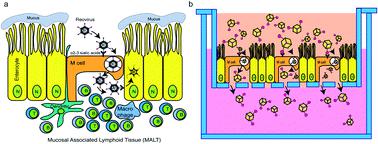Our official English website, www.x-mol.net, welcomes your
feedback! (Note: you will need to create a separate account there.)
Transport of artificial virus-like nanocarriers through intestinal monolayers via microfold cells.
Nanoscale ( IF 5.8 ) Pub Date : 2020-07-08 , DOI: 10.1039/d0nr03680c Tianjian Tong 1 , Yijun Qi , Luke D Bussiere , Michael Wannemuehler , Cathy L Miller , Qun Wang , Chenxu Yu
Nanoscale ( IF 5.8 ) Pub Date : 2020-07-08 , DOI: 10.1039/d0nr03680c Tianjian Tong 1 , Yijun Qi , Luke D Bussiere , Michael Wannemuehler , Cathy L Miller , Qun Wang , Chenxu Yu
Affiliation

|
Compared with subcutaneous or intramuscular routes for vaccination, vaccine delivery via the gastrointestinal mucosa has tremendous potential as it is easy to administer and pain-free. Robust immune responses can be triggered successfully once the vaccine carrying an antigen reaches the mucosal associated lymphoid sites (e.g., Peyer's patches). However, the absence of an efficient delivery method has always been an issue for successful oral vaccine development. In our study, inspired by mammalian orthoreovirus (MRV) transport into the gut mucosal lymphoid tissue via Microfold cells (M cells), artificial virus-like nanocarriers (AVNs), consisting of gold nanocages functionalized with the σ1 protein from mammalian reovirus (MRV), were tested as an effective oral vaccine delivery vehicle targeting M cells. AVNs were shown to have a significantly higher transport compared to other experimental groups across mouse organoid monolayers containing M cells. These findings suggest that AVNs have the potential to be an M cell-specific oral vaccine/drug delivery vehicle.
中文翻译:

人工病毒样纳米载体通过微折叠细胞通过肠道单层运输。
与皮下或肌内接种途径相比,通过胃肠道粘膜递送疫苗具有巨大的潜力,因为它易于管理且无痛。一旦携带抗原的疫苗到达粘膜相关的淋巴样部位(例如,派伊尔氏淋巴结),就可以成功触发强大的免疫反应。然而,缺乏有效的递送方法一直是成功开发口服疫苗的问题。在我们的研究中,受哺乳动物正咽病毒(MRV)的启发,其通过以下途径转运到肠粘膜淋巴组织微折叠细胞(M细胞),人造病毒样纳米载体(AVN),由用哺乳动物呼肠孤病毒(MRV)的σ1蛋白功能化的金纳米笼组成,已作为靶向M细胞的有效口服疫苗递送载体进行了测试。与其他实验组相比,AVNs在包含M细胞的小鼠类器官单层中具有明显更高的转运。这些发现表明,AVNs有可能成为M细胞特异性口服疫苗/药物递送载体。
更新日期:2020-08-06
中文翻译:

人工病毒样纳米载体通过微折叠细胞通过肠道单层运输。
与皮下或肌内接种途径相比,通过胃肠道粘膜递送疫苗具有巨大的潜力,因为它易于管理且无痛。一旦携带抗原的疫苗到达粘膜相关的淋巴样部位(例如,派伊尔氏淋巴结),就可以成功触发强大的免疫反应。然而,缺乏有效的递送方法一直是成功开发口服疫苗的问题。在我们的研究中,受哺乳动物正咽病毒(MRV)的启发,其通过以下途径转运到肠粘膜淋巴组织微折叠细胞(M细胞),人造病毒样纳米载体(AVN),由用哺乳动物呼肠孤病毒(MRV)的σ1蛋白功能化的金纳米笼组成,已作为靶向M细胞的有效口服疫苗递送载体进行了测试。与其他实验组相比,AVNs在包含M细胞的小鼠类器官单层中具有明显更高的转运。这些发现表明,AVNs有可能成为M细胞特异性口服疫苗/药物递送载体。











































 京公网安备 11010802027423号
京公网安备 11010802027423号